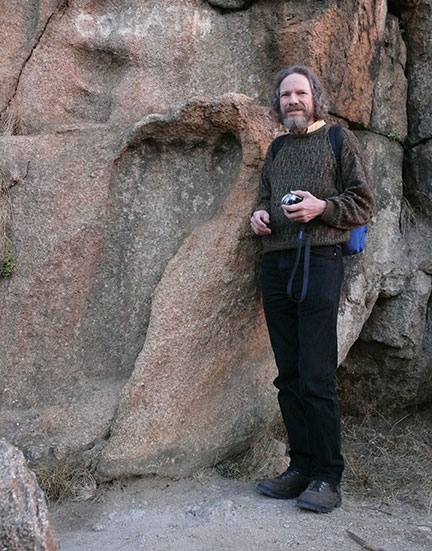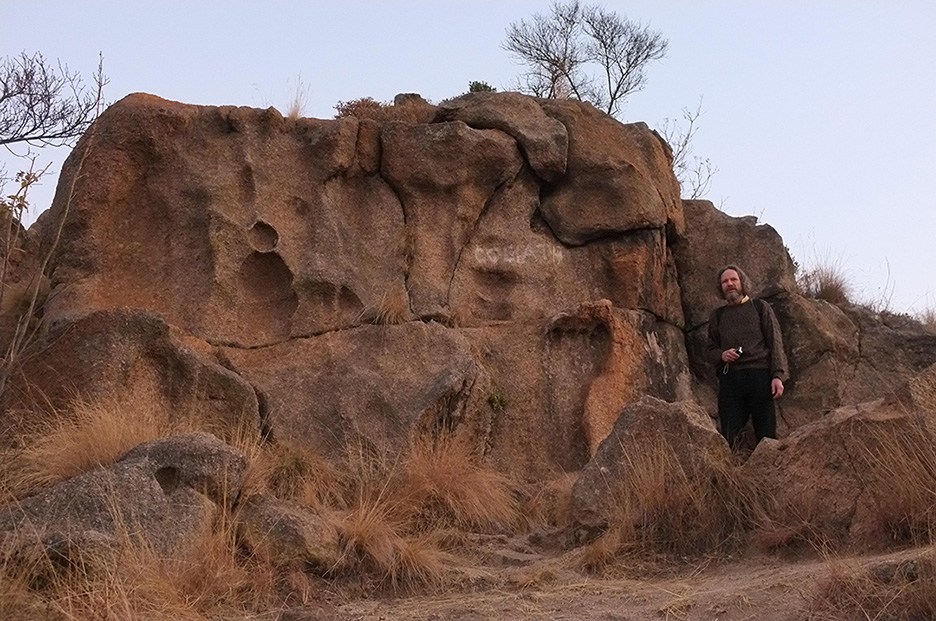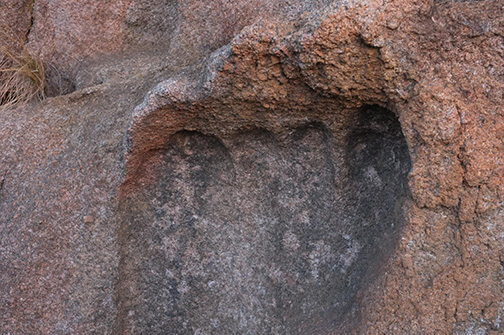The story of the renowned Dr. Robert Milton Schoch and the enigmatic ‘Footprint of God’ found in Swaziland, a captivating region in Southern Africa.

Robert Schoch standing by the so-called “Giant’s Footprint” near Empuluzi, South Africa. Photo: R. Schoch and C. Ulissey.
While visiting South Africa in June 2014, Michael Tellinger (author of, among other books, African Temples of the Annunaki and Slave Species of the Gods) took me to view a reputed giant “footprint” located in a remote area about 300 kilometers due east of Johannesburg in the Eastern Transvaal near the South African town of Empuluzi (also sometimes spelled Mpaluzi) in Mpumalanga, which borders on Swaziland.
We arrived at the site just as the Sun was dipping below the horizon. I have to admit that as soon as I saw the so-called “footprint” I was highly skeptical; indeed, it all seemed rather silly to me. The “footprint”, measuring approximately 1.2 meters from toe to heal, is in granite and oriented vertically on the exposed surface of an outcropping. Only a giant some 7 to 7.5 meters tall could have made a footprint this large, according to Tellinger. My immediate impression, however, which further study and research has only strengthened, was that no giants need be invoked. Here was a wonderful natural weathering and erosion feature – a form that falls into the broad class of erosional features often found in rocks known as tafoni – that in this particular case vaguely resembles a human foot imprint. The “footprint” is a natural simulacrum, not unlike seeing animals, angels, and human faces in the clouds. Reinforcing my first impression that this was nothing more than a natural erosional feature is the fact that the rock face on which it occurs is covered with other weathered-out cavities, one of which reminded me of the silhouette of a small snowman. Had not only a giant stepped into the granite, but a meter tall snowman leaned against the granite as well, impressing the outline of his body onto the rock surface? The problem is granite typically has a melting temperature of over 1200º C, so it seems the giant might have severely burned his foot and the snowman melted rather quickly. But perhaps we have here evidence of a fire-walking giant (and a snowman who plays in fire as well?). Still, there are further complications that must be addressed. Granite forms many kilometers below the surface of our planet, so apparently the giant and snowman were miraculously strolling through a hot, dense, magma composed of melted rock down in the bowels of Earth. It was all a bit too fantastic for me.
However, might it just be possible that my geological instincts were wrong, and this was a genuine footprint of a giant? Forget the snowman, as no one else seemed to recognize it as anything more than a natural feature; it was the “footprint” that received all of the attention.

Overview image of Robert Schoch standing near the granite erosional feature that has been misinterpreted as a giant footprint. Also visible is an erosional feature that resembles a snowman. Photo: R. Schoch and C. Ulissey.
Even Michael Tellinger, the foremost proponent for the authenticity of the “footprint”, admitted that he would be hard pressed to explain how a giant could be striding through molten granite several kilometers below the surface. He had another explanation, which he shared with us. An old-time miner had related that when quarrying granite, sometimes a powdered form of the rock could form a wet, slushy, mixture that would congeal and harden as a type of cement. Tellinger hypothesized that a giant (or giants) in ancient times was carrying out mining operations in the granite, stepped into a wet pulverized granite slurry (sort of a “mud” of powdered granite), and later the granite slurry dried, reconstituted itself, and preserved the impression of the footprint. He noted that at the top of the “footprint” one could even detect the mud that oozed between the toes and was pushed up by the foot of the giant. This presumably happened in very ancient times (possibly a couple of hundred thousand years ago?) and since then, through various geological processes, the original footprint, which would have been horizontal, was uplifted and tilted to its current vertical position.
This is an ingenious explanation of how a footprint might be preserved in “granite” – it gave me pause and some of the group with us seemed to accept it as quite plausible – but from a geological point of view it does not hold up to scrutiny. An important point is that, according to Tellinger’s hypothesis, the rock in which the footprint is now found would no longer technically be granite, but a re-mineralized surface rock superficially mimicking granite. As a Ph.D. geologist, I believe that I can tell the difference between genuine (naturally formed) granites and re-mineralized “pseudo-granites”. Looking carefully at the rock composing the giant “footprint”, it contains coarse crystals of feldspars, quartz, micas, and other minerals typical of granite. I do not believe that there is any known means by which these crystals could have grown and congealed to form the stone seen other than at very hot temperatures and high pressures deep below the surface of our planet. In simple language, the “footprint” is found in genuine granite, not a re-mineralized rock (not a “pseudo-granite”) that mimics genuine granite.

Close-up image of the erosional feature that has been misinterpreted to be a giant footprint. Photo: R. Schoch and C. Ulissey.
If I am correct in my assessment that the “footprint” occurs in genuine granite – and I am 100% certain that this is the case – then there is no conceivable possibility that it really is the footprint of a giant or any other living creature. So what is the “footprint”? As I already related, my first impression was that it is nothing more than a natural erosional feature. This is still my first hypothesis, although I cannot totally dismiss the possibility that it was either artificially carved into the rock or that it may have initially been a natural weathering feature that only vaguely looked like a footprint originally and was subsequently enhanced and retouched by humans to turn it into a full-fledged “footprint”. Arguing against the possibility that it was either carved in full or in part is the fact that I could not find any evidence of tool marks on the surface of the granite. However, the granite surface is highly weathered. One could hypothesize that it is a sculpted form, but extremely old, perhaps thousands of years old.
Looking at the stone closely, it is beautiful and telling granite, which in and of itself relates a very ancient story.
The granite outcropping in which the “footprint” appears is part of the rock unit known to geologists as the Mpuluzi Batholith (a batholith is a large body of igneous rock that forms deep in Earth’s crust; a batholith may originate as the core of a mountain chain, and long after it was formed may be exposed at the surface by natural uplift and erosive processes). The Mpuluzi Batholith has been studied extensively and, based on isotope analyses, this granite dates back an astounding 3,100 million years ago. The Mpuluzi Batholith is part of the Kaapvaal Craton, which covers a good portion of northern South Africa, Swaziland, southern Botswana, part of Lesotho, and small portions of Zimbabwe and Mozambique. In geology, a craton is an old and stable portion of the crust of Earth, and the Kaapvaal Craton is often considered, along with the Pilbara Craton in Australia, to be one of the oldest relatively pristine portions of crust that still exists on our planet, dating back to the Archean (Archaean, Archaeozoic) Eon, circa 2,500 million to 4,000 million years ago. As a geologist, thinking about the age of this granite is thrilling and dizzying. The Earth was such a different place back then. The atmosphere lacked free oxygen. The highest life forms that we know of from that early period were microbes, which in some cases formed photosynthetic bacterial layers or mats. There is no evidence of giants on Earth back then – that is, unless you accept the single giant “footprint” found in the Mpuluzi Batholith.
Related Post
A shocking documentary proves that mermaids do exist
SHOCKING Revelation: Thuya, Mother of Queen Tiye, Was the Grandmother of Akhenaten and Tutankhamun—What Ancient Egyptian Secrets Did She Leave Behind?
Breaking News: Astonishing Discoveries at Karahan Tepe Confirm an Extraterrestrial Civilization is Hiding on Earth, and NO ONE Knows!
Breaking News: Researchers FINALLY Discover U.S. Navy Flight 19 After 75 Years Lost in the Bermuda Triangle!
NASA’s Secret Investigation: Uncovering the Astonishing Mystery of the UFO Crash on the Mountain!
Explosive UFO Docs LEAKED: Startling Proof That Aliens Ruled Ancient Egypt!